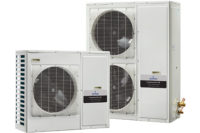That's one of the options being offered by Emerson Climate Technologies, especially when it comes to those smaller (1/6- to 1/2-hp) units that might be found in commercial kitchens or other food service environments.
Several factors go into making a decision to try to repair or just replace an entire condensing unit, said Bob Labbett, vice president of Emerson Distribution Services. One is the process involved in finding the component culprit in a condensing system. "Compressor failure, for example, is all too often just a symptom of a larger system problem," he said.
Even if the problem can be found, there are the time-consuming processes of recovering refrigerant, disconnecting power, removing refrigerant lines, cleaning up, replacing the defective component - and then reconnecting and recharging, etc.

In The Restaurant
Tom Parrish, Emerson's manager of marketing and sales services for integrated products, noted the special challenges of a "rugged commercial kitchen environment with high heat, fan motor wear, and coil contamination. There is a very high ambient of maybe 120 degrees F and coils can get fouled."He noted that most system failures are caused by contamination. Surface contamination can cover coils and components, or internal contamination from newer oils and refrigerants can leave acids in the system. In other words, replacing just one component in a condensing unit may not solve the problem.
"The tough environments of today's kitchens often choke off airflow from the equipment," said Parrish, "reducing efficiency and accelerating premature failure. Combine that with a harsh environment and a possible lack of preventive maintenance and you'll soon follow up that compressor replacement with service calls for new controls, new wiring, new fan motors, or cap tubes.
"These additional service calls can lead to lifecycle costs that exceed the initial first-cost savings of only replacing a failed compressor. Choosing to replace the entire unit simply brings the end user's piece of equipment back to factory performance standards, at a total cost that is more economical to the end user in the long term."

Replacing The Entire Unit
That is why Emerson recommends giving consideration to replacing the entire condensing unit. Its Web site includes a cross reference/replacement guide.There are replacements for low-temperature units (-10 degrees evaporative, 90 degrees ambient) that have been running on R-12, -134a, and -404A. On the high-temperature side (45 degrees evap, 90 degrees ambient), there are units that can run on those three refrigerants, as well as R-22.
Replacement units are shipped with the appropriate oil. In the case of replacing an original R-12 unit, Emerson has made available retrofit guidelines for transition to HFC and HCFC refrigerants. The guidelines include the use of interim refrigerants such as R-401A and -401B. Otherwise, the new condensing units will work with the HCFC or HFC refrigerant that was being used in the unit being replaced.
In addition, special filter-driers are available for the food service environment, Parrish pointed out. EK Cap driers work with newer refrigerants and oils and are designed to deal with excessive moisture and contaminants. Synthetic oils are protected from containments by a beaded desiccant, the company said.
Parrish said one benefit of clean, new units is their higher efficiencies. But preventive maintenance is still needed on any equipment, old or new.
Labbett said Emerson representatives have been calling on contractors both to explain the replace-rather-than-repair concept and show how models can be matched. "We stress the contractor's reputation and say this is something they ought to do."
For more information, visit www.emersonclimatecontractor.com.
Publication date: 09/05/2005


